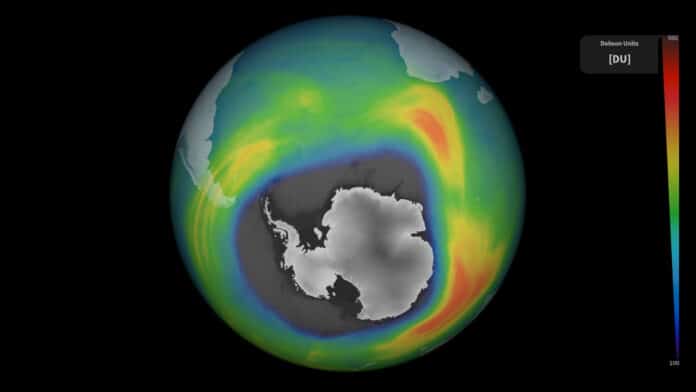The ozone hole’s size changes frequently. The ozone hole’s size increases from August through October, peaking between mid-September and mid-October. The polar vortex begins to weaken and eventually dissipate as southern hemisphere stratospheric temperatures climb. By the end of December, ozone levels are back to normal.
This year’s ozone hole over Antarctica is one of the biggest on record, according to measurements from the Copernicus Sentinel-5P satellite. On September 16, 2023, the ‘ozone depletion area,’ as scientists refer to the hole, grew to 26 million square kilometers. The size of this is around three times that of Brazil.
Copernicus Sentinel-5P – short for Sentinel-5 Precursor – is the first Copernicus satellite dedicated to monitoring our atmosphere. Launched in October 2017, the satellite carries an advanced multispectral imaging spectrometer called Tropomi. It detects the unique fingerprints of atmospheric gases in different parts of the electromagnetic spectrum to image a wide range of pollutants more accurately and at a higher spatial resolution.
Diego Loyola, DLR senior scientist, commented, “The Sentinel-5P total ozone products have an accuracy at the percentage level compared with ground-based data, allowing us to monitor the ozone layer and its evolution closely. The Tropomi measurements extend the global ozone data record of European satellite sensors covering almost three decades.”
The Sentinel-5P total ozone column product is provided to the Copernicus Atmosphere Monitoring Service (CAMS) within three hours after measurement time.
CAMS senior scientist Antje Inness said, “Our operational ozone monitoring and forecasting service shows that the 2023 ozone hole started early and has increased since mid-August. It reached a size of over 26 million sq km on September 16, making it one of the biggest ozone holes on record. Tropomi ozone data are an important dataset for our ozone analysis.”
ESA‘s mission manager for Copernicus Sentinel-5P, Claus Zehner, adds, “The Sentinel-5P total ozone columns provide an accurate means to monitor ozone hole occurrences from space. Ozone hole phenomena cannot be used straightforwardly for monitoring global ozone changes as they are determined by the strength of regional wind fields that flow around polar areas.”
